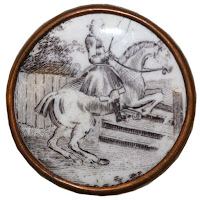Object Focus: Four buttons from what would have been a larger set of gentlemen's buttons depicting hunting scenes. Above a gentleman leans on his horse with his hunting dogs around, and below are images of the hunt.
The buttons were probably produced between about 1760 and 1770. With their enamelled centre and gilt surround, they were possibly a product of Taylor's manufactory which used both these techniques. The button design was transfer printed onto enamel, and Taylor was practising transfer printing from at least 1765. Transfer-printing was developed in the late 1740s and early 1750s in Birmingham, after being invented probably in Liverpool. It allowed copperplate images to be printed onto the shiny surfaces of enamel and porcelain, allowing for mass production as one print could produce thousands of buttons.
 |
| Held at the MET Museum. |
Open the whole button box.



